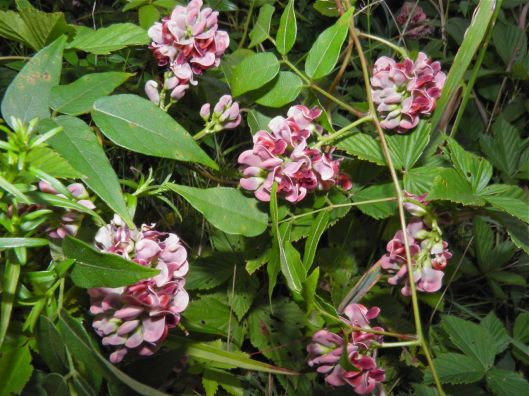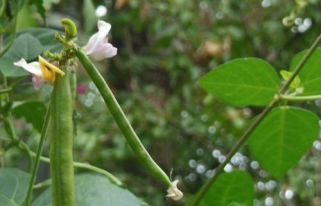Tags

Ground nut is a North American native and produces a tuber similar to a potato. It is edible as are the beans, shoots, and flowers the plant produces. In 1585 Thomas Harriot said of it, “Openauk, a kind of root of round form, some of the bigness of walnuts, some far greater, which are found in moist & marish [sic] grounds growing many together one by another in ropes, or as though they were fastened with a string. Being boiled or sodden they are very good meat…”.

One can hardly read a natural history, book of Indian lore, or an account of pioneers or mountain men without finding a reference to hopniss (the Lenape word for the plant) or Indian potato. Accounts as early as 1626 call it Indian potato and by 1787 it was Apios Americana. Lewis and Clark described it in their journals. The name varied with tribe but each used it as food and as a medicinal.

Modern day permaculturists praise the plant, but it is nothing new to history. The noted botanist, Peter Kalm, recorded the plant he called hopniss in his journal in March 1749, written from Raccoon Creek New Jersey. “Hopniss or Hapniss was the Indian name of a wild plant which they ate at that time. The Swedes call it by that name, and it grows in the meadows, in good soil. The roots resemble potatoes, and are boiled by the Indians who eat them instead of bread. Some of the Swedes, at that time, likewise ate this root for want of bread. Some of the English still eat them instead of potatoes, but likewise take the peas that lie in the pods of this plant and prepare them like common peas.”
Further, Parkman in “Pioneers of France” stated that Charles de Biencourt and his followers at Port Royal [Acadia, New France, now Canada], in 1613, were scattered about the woods and shores digging ground-nuts. Jacob Cornutus published a history of the plants of Canada in Paris in 1635 in which is found the ground-nut. Jane Loudon included the plant in her “The Ladies’ Flower-garden of Ornamental Perennials” and in discussing the edibility of the tubers noted that the plant had been introduced in England before 1640 and was cultivated in Germany (1843) where the tubers were sold in markets. Whittier spoke of “Where the ground-nut trails its vine” in his “The Bare-footed Boy”.
Henry David Thoreau wrote about these tubers in his journal. October 12, 1852. I dug some ground nuts with my hands in the railroad sand bank, just at the bottom of the high embankment on the edge of the meadow. These were nearly as large as hen’s eggs. I had them roasted and boiled at supper time. The skins came off readily, like a potato’s. Roasted they had an agreeable taste, very much like a common potato, though they were somewhat fibrous in texture. With my eyes shut I should not have known but I was eating a somewhat soggy potato. Boiled they were unexpectedly quite dry, and though in this instance a little strong, had a more nutty flavor. With a little salt a hungry man could make a very palatable meal on them.
On March 17, 1849 an article on apios tuberosa was published in “The Gardener’s Chronicle” which discussed its introduction to Ireland during the potato famine. “The apios has a curious underground vegetation; its roots are the size of a quill pen, cylindrical, running horizontally under the soil, but close to its surface, and are often two meters long, and sometimes much longer than that. Here and there the roots swell insensibly; the swellings gradually become spindle-shaped, grow larger, become filled with starch, and form true tubers. The swellings are sometimes close together, so as to form a sort of chaplet.” The woodcut that accompanied the article was a fine likeness.
As to flavor the tubers were compared to a chestnut or potato with a bit of artichoke, “which is by no means unpleasant”. It is almost certainly the Jerusalem artichoke being discussed as other 1840’s sources specify such.
A research team at Southern Louisiana State University invested twelve years in improving the size of the tubers and the number of tubers produced per plant under the direction of Professor Bill Blackmon. Unfortunately the research was abandoned after Professor Blackmon left the university so we aren’t likely to see them perfected to the point that they are cost efficient to grow commercially. The tubers going into our garden were ordered from Sow True Seed and were cultivated from that improved LSU stock. At least two universities have done studies on the nutrition-packed tubers and found they contain significant isofavones, chemicals linked to a decreased incidence of prostate and breast cancers.
Plants are drought tolerant and perennial. It is slow to establish itself and tubers should not be harvested its first year. In fact some growers recommend waiting until the third year to harvest tubers. Tubers grow on a stringy root and resemble beads on a necklace. The tubers may be some distance from where the plant grows so it is best to start at the plant and follow the string wherever it goes. Descriptions of growth habit vary from a vine that grows to six foot long to twenty feet. It is a nitrogen fixing plant meaning it pulls nitrogen from the soil to the surface where it can nourish nearby plants.
The vine is thin, covered with fine hair and rather tough for its size. Leaves are pinnately compound with three to nine two-inch leaflets (3, 5, 7, or 9) with no teeth. The flowers are a lavender/brown color and fragrant. Tubers vary in size from dime size up to grapefruit size, though the larger tubers usually average about the size of an egg. Second or third year tubers are the largest. Those can be harvested and the smaller ones replanted. Tubers can be dug any time of year, but the tubers are sweetest in the fall. Seeds grow in a pod and can be harvested before they dry enough that the pod shatters sending seed everywhere.
Seeds do not always germinate well, however, and the plants are usually started from tubers planting them individually or in strings. Suckers can come up some distance away from the host plant. Vines can be pruned to keep them from spreading too much.
“Most of the research involving cultural practices has been directed towards developing techniques to screen large numbers of plants. Direct-seeding has presented problems. Seeds may take 10 to 30 days to germinate. Seedlings are small and early seedling growth is not vigorous. Seedling death, presumably from insects or diseases, has plagued this technique for starting apios. The most satisfactory method has been to start plants in peat pellets. After germination, when the shoots begin elongation, the plants are pinched back to the first leaves. This prevents the plants in a flat from twining on each other, allows for better root development prior to planting, and permits plants from slower germinating seed to reach sufficient size to transplant. However, pinching back carries a potential risk of spreading disease among the seedlings. Weak seedlings can be discarded at this stage.
Tubers are planted intact. The buds that give rise to the shoots and rhizomes occur at the distal end of the tubers. The potential of dividing tubers into sections prior to planting needs evaluation. Generally the larger the tuber, the more rapid the early growth. Seeds may be harvested from the time the pods first begin to dry. If left on the vine too long some pods will shatter. Tubers are harvested after frost. Since most of the plants are different (originating from seeds), the tubers are harvested with a shovel to insure that genotypes can be evaluated individually. Fortunately, tubers can remain in the soil for extended periods without rotting even under water-logged conditions, thus allowing an extended harvest period.
Although apios in its native habitat is found growing on water-logged and acidic soils (Reed and Blackmon 1985), observations under field conditions indicate that apios grows best on well-drained soils. A pH less than 5 or as high as 8 may also be detrimental to growth. Adequate moisture is important, but excess moisture encourages longer rhizomes.” Perdue crop proceedings 1990.
Eat them boiled, roasted, or slice and fry them after boiling. Tubers can substitute for potatoes in any dish though the flavor has been described as nuttier than potato and they can be cooked peeled or unpeeled. The tubers can be dried, ground, and used like flour to add to bread or to thicken soup or stew. The flowers are edible raw or cooked and the seeds can be shelled and cooked. The seedpods can be cooked like green beans if harvested before they become tough and fibrous. The tubers have a much higher percentage of protein than potatoes.
I’ve planted these along with Jerusalem artichokes and I’m watching to see if they come up. As long as the chickens or squirrels don’t dig up the tubers I should be fine in which case I should have tubers I can harvest in two to three years. Blissful Meals, friends, and happy gardening.©






You must be logged in to post a comment.